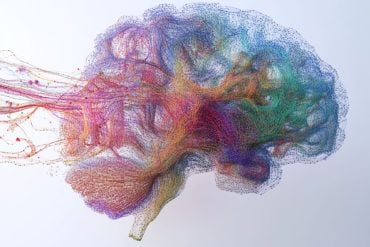Summary: Researchers shed light on how we are able to effectively form mental images of how objects look to other people.
Source: University of Plymouth.
Everyday life is full of situations that require us to take others’ perspectives – for example, when showing a book to a child, we intuitively know how to hold it so that they can see it well, even if it is harder to see for ourselves. Or when performing before an audience, we often can’t help but picture how we will look to the other people.
New research published in ‘Current Biology’ has provided the first direct evidence that we can do this because we spontaneously form mental images of how the world looks to the other person, so that we can virtually see through their eyes and make judgements as if it was what we were seeing.
The study, led by Eleanor Ward, Dr Giorgio Ganis and Dr Patric Bach at the University of Plymouth, focused on a mental rotation task commonly used in psychology, where participants are asked whether a rotated letter on computer screen is presented in its standard form (e.g. “R”) or mirror-inverted form (“Я”). Usually, the more a letter is rotated away from the person judging it, the longer it takes to decide its form. The reason for this is that people first have to mentally rotate the object back to its upright orientation before being able to judge its form, and this rotation takes longer the more the letter is oriented away.
But the new study reveals that people can bypass this mental rotation when another person is introduced. The study shows that even when items are oriented away from participants, their decision times are surprisingly fast if the item appears upright to the other person and is therefore easily identifiable from their perspective. In contrast, if the letter appears upside down for the other person, even relatively easy judgements become harder for the participants.
Lead author Eleanor Ward, PhD student in the University of Plymouth School of Psychology explained:
“This study shows that what we see can be overridden by what another person sees if it helps us to make a judgement. People do not need to mentally rotate an object if they already ‘see’ the object in the usual upright orientation from the eyes of another. People did this even though we did not give them instructions about the extra person introduced and they viewed them completely passively. They still used the extra set of eyes, which suggests it is a process that occurs spontaneously.”
Importantly, the study did not find the same speeding up of judgments when an inanimate object (a lamp) was introduced instead of a person, even though the lamp was roughly the same size and was oriented towards the letter in the same way as the person’s. This makes sense as a lamp can’t ‘see’ so participants would not construct an image of how the world looks to an inanimate object.
Eleanor continued:
“Imagine you’re in a car and you see a pedestrian crossing the road, and a bus is travelling at speed towards the crossing. Suddenly you realize the driver hasn’t seen the pedestrian and could hit them, so you beep your horn. How did you make this split-second decision? Our study suggests you automatically put yourself in the bus driver’s shoes and saw the scene through their eyes.”

Dr Patric Bach, who is the head of the Action Prediction Lab where the research was carried out, added:
“Perspective taking is an important part of social cognition. It helps us understand how the world looks from another’s point of view. It is important for many everyday activities in which we need interact with other people. It helps us to empathise with them, or to work out what they are thinking. Our study provides new insights that people can do this because they very quickly and spontaneously form a mental image of how the world looks to another person. As soon as we have such a mental image, it is easy to put ourselves in the other person’s place and to predict how they will behave.”
Source: Amy King – University of Plymouth
Publisher: Organized by NeuroscienceNews.com.
Image Source: NeuroscienceNews.com image is adapted from the University of Plymouth news release.
Original Research: Open access research for “Spontaneous Vicarious Perception of the Content of Another’s Visual Perspective” by Eleanor Ward, Giorgio Ganis, and Patric Bach in Current Biology. Published February 21 2019.
doi:10.1016/j.cub.2019.01.046
[cbtabs][cbtab title=”MLA”]University of Plymouth”Seeing Through Another’s Eyes: How We Use Others’ Viewpoints to Make Decisions.” NeuroscienceNews. NeuroscienceNews, 22 February 2019.
<https://neurosciencenews.com/decisions-others-viewpoints-10796/>.[/cbtab][cbtab title=”APA”]University of Plymouth(2019, February 22). Seeing Through Another’s Eyes: How We Use Others’ Viewpoints to Make Decisions. NeuroscienceNews. Retrieved February 22, 2019 from https://neurosciencenews.com/decisions-others-viewpoints-10796/[/cbtab][cbtab title=”Chicago”]University of Plymouth”Seeing Through Another’s Eyes: How We Use Others’ Viewpoints to Make Decisions.” https://neurosciencenews.com/decisions-others-viewpoints-10796/ (accessed February 22, 2019).[/cbtab][/cbtabs]
Abstract
Spontaneous Vicarious Perception of the Content of Another’s Visual Perspective
Visual perspective taking (VPT) is a core process of social cognition, providing humans with insights into what the environment looks like from another’s point of view. While VPT is often described as a quasi-perceptual phenomenon, evidence for this proposal has been lacking. Here, we provide direct evidence that another’s perspective can “stand in” for one’s own sensory input during perceptual decision making. In a variant of the classic mental rotation task, participants judged whether characters presented in different orientations were canonical or mirror inverted. In the absence of another person, we replicate the well-established positive linear relationship between recognition times and angle of orientation such that recognition becomes slower the more an item has to be mentally rotated into its canonical orientation. Importantly, this relationship was disrupted simply by placing another individual in the scene. Items rotated away from the participant were recognized more rapidly the closer they appeared in their canonical orientation, not only to the participant, but also to this other individual, showing that another’s visual perspective drives mental rotation and item recognition in a similar way as one’s own visual perspective. The effects were large and replicated in the three independent studies. They were observed even when the other person was completely passive, enhanced when the participant was explicitly instructed to take the other person’s perspective, but reduced when the persons in the scenes were replaced with objects. The content of another’s perspective is therefore spontaneously derived, takes a quasi-perceptual form, and can stand in for one’s own sensory input during perceptual decision making.






